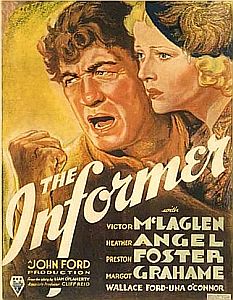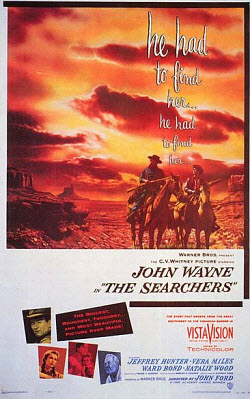 I’m posting this blog a little earlier than normal to have it up for St. Patrick’s Day weekend. Now on to the movie … director John Ford’s masterpiece, The Informer (1935).
I’m posting this blog a little earlier than normal to have it up for St. Patrick’s Day weekend. Now on to the movie … director John Ford’s masterpiece, The Informer (1935).
I think of this film as John Ford’s flip-side to The Quiet Man (1952), a whimsical look at the Emerald Isle that I regularly watch on St. Patrick’s Day (in fact, I’ll be seeing a newly restored version at my brother’s home theater this weekend). By contrast, The Informer shows the ugly side of Ireland in the wake of The Special Powers Act of 1922. While The Quiet Man is a fairy tale, shot in Technicolor and tinted ever-so-subtlety in green, The Informer has an almost film noir quality to it with its exquisite use of light and shadow playing against a thick foggy back-drop.
I’ve encountered people like the main character, Gypo Nolan, played by Victor McLaglen in the performance of a lifetime. It’s hard to brand Gypo as being a fool, a traitor, a hero, or even a victim – because each of these descriptions requires, at least to some extent, that the person being so described have the capacity to behave rationally. I see him more as an animal. He’s not a mad-dog, snarling and lunging at all who cross his path; nor is he a slinking, slithering snake waiting to ensnare another hapless victim. He’s more like a bull: huge, strong, seemingly invincible – until he feels the matador’s blade.
Of course, just because Gypo isn’t “bad” doesn’t mean he isn’t dangerous…
Gypo Nolan is seemingly without reason, without intellect, and at times almost without self-awareness as he’s led around on a figurative leash by his fawning toady. He’s a very popular guy as long as the money holds out. And all the while Gypo, with only the vaguest notion of an idea living just outside his grasp, goes along with everything that comes his way – in one drunken stupor after another – unaware of his own actions until long after their consequences have played themselves out.
And as we see several times in the film, these consequences can be dire.
One could almost pity Gypo; however, I found myself filled more with scorn. Unlike the creature played so brilliantly by Boris Karloff in Frankenstein (1931), who was thrust into a world that feared and despised him, thereby making him sympathetic, Gypo, a fully grown adult, should know better. Although one might be tempted to call him an innocent (if he truly has little to no capacity for reasoned thinking – how can he really be blameworthy?), I found it hard to feel sorry for him – any more than I’d feel sorry for a Ferrel cat wandering through the alley looking for a rat or two to dine upon.
As a character study, this film can’t be beat. The drama is taught throughout but never forced. And it’s got some of the best black-and-white cinematography I’ve ever seen (which makes me wonder how the Director of Photography, Joseph H. August, didn’t get an Oscar). I truly can’t recommend this film highly enough – by all means, see it!
 The Searchers (1956) is one of many classic pairings between The Duke and director John Ford.
The Searchers (1956) is one of many classic pairings between The Duke and director John Ford. I’m posting this blog a little earlier than normal to have it up for St. Patrick’s Day weekend. Now on to the movie … director John Ford’s masterpiece,
I’m posting this blog a little earlier than normal to have it up for St. Patrick’s Day weekend. Now on to the movie … director John Ford’s masterpiece,